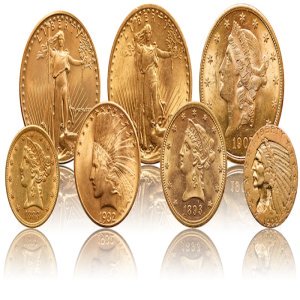Pre 1933 US Gold
US Mint Pre-1933 gold coins are leading investment choice that is a connection to history.
Learn More About Pre 1933 US Gold

While the US Mint halted their issuance for circulation in 1933, gold coins have been a central part of our nation's history since The Coinage Act of 1794.
The Act defined the specifications for the $10 Gold Eagle, $5 Half Eagle, and $2.50 Quarter Eagle. Each coin was minted with a specific amount of gold roughly equivalent to its face value during that era.
Pre-1933 gold coins are among the most sought-after precious metals investments today due to their legal tender status, historical connection, and low premium over spot price.
For those who enjoy history, collecting pre-1933 US Mint coins can be an educational endeavor. It offers insights into different periods of American history, including the economy, coinage, and minting processes.
Pre-1933 Gold Coin Investment
Today, these Pre-1933 Gold Coins are tangible assets, with the intrinsic melt value providing a base price.
Coins from years with lower mintages, certain mint marks, and various types have increasing numismatic value among collectors. With some exceptions, most circulated coins are often common dates and from high mintage years, providing low premiums, making them an ideal store of value.
These vintage gold coins were issued in standard denominations, each containing a specific amount of gold defined in the Coinage Acts.
- $20 Double Eagle Gold Coins - The first Double Eagle was minted in 1849 and featured the Liberty Head design by James B. Longacre. The Saint-Gaudens Double Eagle later replaced the design in 1907, and it is considered one of the most beautiful American coins ever minted. Augustus Saint-Gaudens' design features Lady Liberty on the obverse and a majestic eagle on the reverse. All double eagles were minted with .9675 oz gold; the composition includes a small amount of copper for durability, giving them a fineness of .900.
- $10 Eagle Gold Coins - The first $10 Eagle was minted in 1795 and featured Robert Scot's Liberty Cap design. This design was later replaced by the Christian Gobrecht Coronet Head design in 1838, featuring a portrait of Liberty wearing a coronet on the obverse and an eagle with a shield on its breast on the reverse. The composition of these coins was 90% gold and 10% copper. The $10 Gold Indian was introduced in 1907 and features Liberty wearing an Indian headdress. Each $10 Gold Eagle contains .4838 oz of gold.
- $5 Half Eagle Gold Coins—The first $5 Half Eagle was minted in 1795 and featured the Robert Scot design. In 1907, the Liberty Head design was replaced with the Incuse Indian. The half eagle was minted until 1929, with a brief interruption during the Civil War. Each coin contains 0.2419 oz of gold.
- $2.50 Quarter Eagle Gold Coins - The first $2.50 quarter eagle was issued in 1796. The Gobrecht quarter eagle was first mined in 1840 and carries the same design as other coins in the series. The Incuse quarter eagle was introduced in 1907 and remained in circulation until 1929. Each $2.50 Quarter Eagle contains 0.121 oz of gold.
- $1 Gold Coins - The United States had a surplus of gold resulting from the California Gold Rush. Congress decided to create a new $1 Gold piece for circulation. The first $1 Gold coin was issued in 1849 and contains 0.04837 troy ounces of gold.
Given these gold coins' historical and numismatic significance, some investors believe that pre-1933 coins might be exempt from potential future gold confiscation efforts.
US Mint Pre-1933 Gold Coins
The weights, sizes, denominations, and designs differ from modern bullion coins. However, they still have certain similarities, such as legal tender status and the face value of primary denominations.
The three most popular designs of Pre-1933 gold coins are the Indian Head, Saint-Gaudens, and Liberty Head designs.
Other, less common coins, such as the $3 gold coin and $1 gold piece, were also minted. Their finite supply increases their rarity and numismatic value.
Liberty Head Eagles
The Liberty Head Gold Series, sometimes referred to as the Coronet Head, features Lady Liberty facing leftward and adorned with a coronet atop her head. Thirteen stars are incorporated around the central design. Millions of Liberty Head gold coins were minted between 1849 and 1907, with many surviving the great melt of 1933.
Indian Head Eagles
The Indian Head Gold Coin incorporates an image of a Native American chief on the obverse side that celebrates the Indigenous cultural history of the United States. The $10 Indian Gold piece featured Lady Liberty adorned with a Native American address. The $2.50 and $5.00 denominations incorporated a Native American chief with an incuse design, meaning the details are sunken into the coin rather than being raised.
The Indian Head series of coins was minted from 1907 until 1916 and irregularly until 1933.
Double Eagle
The Saint Gaudens Double Eagle Gold Coin depicts Lady Liberty walking with an olive branch in one hand and a torch in the other, with the Capitol Building visible behind her. The same design inspired the American Gold Eagle coin.
The Saint-Gaudens double eagle is a twenty-dollar gold coin minted by the United States Mint from 1907 to 1933.







 - Random Year.jpg)








































